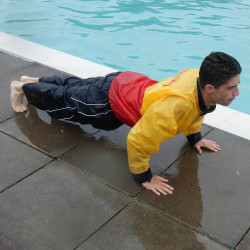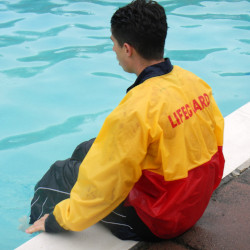Mission Statement
The Free Lifesaving Society publishes free survival swimming and lifeguard training materials for teams worldwide, especially in developing countries where they are needed most.
We focus on offering essential lifesaving skills and training to ensure safety and prevent drowning in insufficiently served regions.
Lesson Resources
This website provides a free lesson support system
for your lifesaving classes and water safety training.
You may copy and share our content for educational use if you quote us as source with a backlink.
For your classes just print any pages as handouts.
The design is mobile friendly so you can use it in your lessons if you have a waterproof device.
Fitness and Skills
Reader Question:
Why do you Fools swim in Clothes? Isn't that Dangerous?
Yes, it can be dangerous if you're not trained and fully prepared to handle this. In Japan, according to police statistcs, ca. 80% of drowning victims (4 in 5) are fully clothed and couldn't cope with this when they accidentially fell into deep water.
That's why we put such an emphasis on swimming in clothes and integrate it into our training
to build confidence, strength and endurance.
We recommend that you and your team include this into your regular sessions
to get everybody ready and able to cope.
Besides, it adds a lot of fun to your lessons.
Survival Swimming
Lifesaving Lessons
If You See Someone in Trouble
- Keep calm and think before you act.
- Try to get help. Shout "HELP, HELP!" as loud as you can.
- Reach out with a stick, a pole, a towel or clothing to pull the person to the edge of the water. Lie down and hold onto something to make sure you don't get pulled in.
- If you can't reach the person and no-one comes when you shout for help, find the nearest telephone and ring 112 in Europe or 911 in USA.
- Avoid jumping into the water yourself. This is only the last resort if you're fully trained.
Affiliate Links
Our articles and posts may contain affiliate links to products we use and recommend.
If you buy something through one of these links,
you won’t pay a penny more but we’ll receive a small commission,
which helps keep us in the water.
Many thanks.


 Help your community. Promote survival swimming and lifesaving.
Read more
Help your community. Promote survival swimming and lifesaving.
Read more